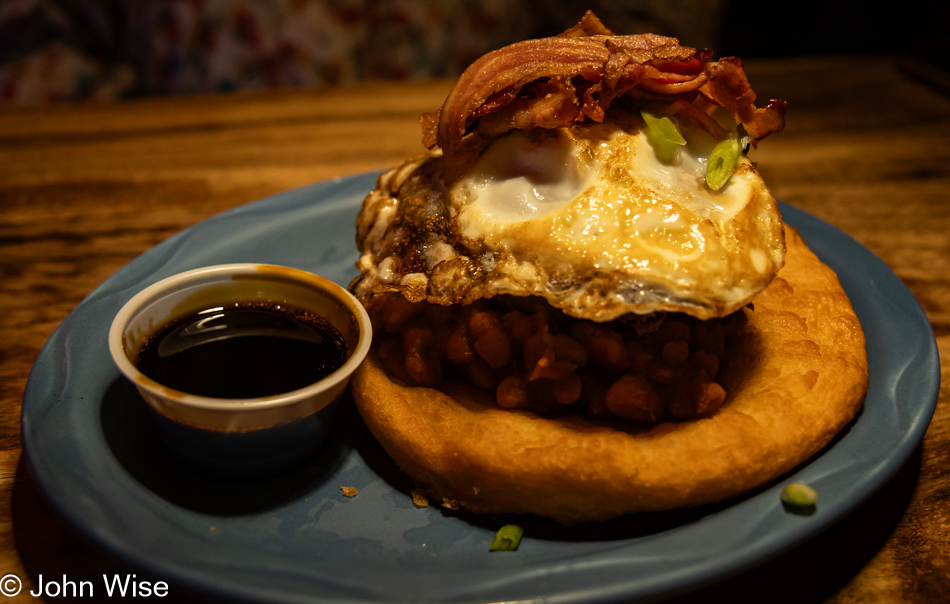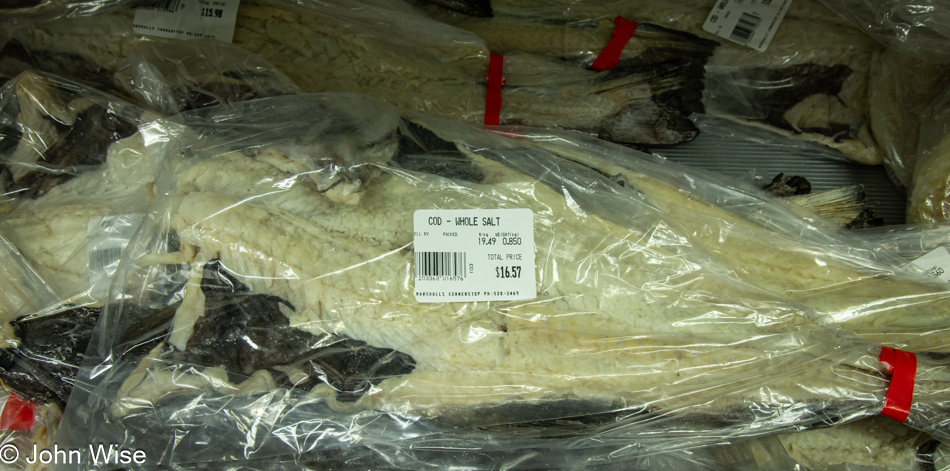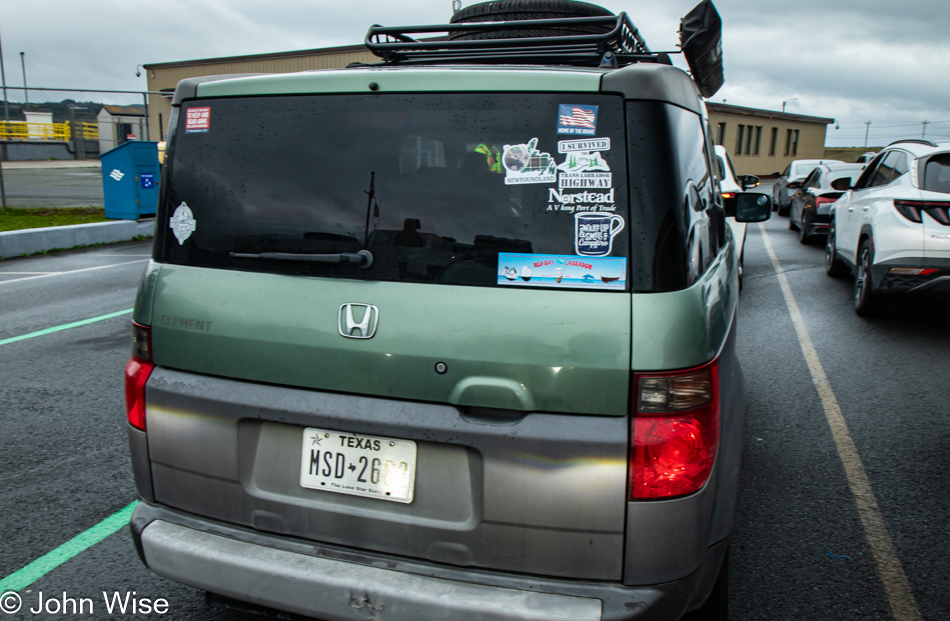
When you hear of a restaurant named the Bagel Cafe, your expectations might not be very high, but my research while building out our travel plans suggested that this place was likely worth a visit. This photo does zero justice to the ambiance that smacks at your senses when you walk in from the street; it shows you but one angle of an immersive experience with a warmth that would shake anyone out of the blues that might accompany a winter day or a rainy morning such as we are having today.

The specialty on offer at the Bagel Cafe is the touton. Similar to Navajo fry bread, the traditional touton (pronounced tau-ten) is fried bread dough but served with a portion of molasses. Caroline ordered the Cape Spear touton with a touton at the base, topped with molasses baked beans, a fish cake, a fried egg, and bacon. The ramekin contains molasses. I opted for the Harbour Main, a touton topped with a large piece of fried cod, eggs, hollandaise, and smoked salmon, a benedict like no other.
Before moving on with this day, Caroline pointed out that I hadn’t mentioned an important detail regarding our stay in St. John’s. This was the first hotel we’d stayed at where we had no contact with any staff. We received an email ahead of our arrival with a four-digit code to unlock the front door and enter the hotel, and our room key was taped to our door in an envelope. From reading the hotel’s instructions, we understood that we’d have to request housekeeping to make up our room or change towels, so we didn’t bother putting a “don’t disturb” sign on the door handle. Well, last night, when we came back in for our second-night stay, we found that someone had entered our room, started to make things up until they got to my CPAP, thought better of shifting anything, and abandoned the attempt, leaving us a printed note that they had quit due to personal items in the way. In any case, the location was perfect, and there was plenty of free parking on the street, though we opted to park in the garage across the street, thinking it might be more secure. On subsequent entries to the hotel, the peculiar smells I mentioned yesterday were not encountered again. Should we visit St. John’s again, we’ll certainly book another stay there.

We left the city in the rain and were intent on getting to our next destination as we felt pressed for time. We had driven through almost the entire town of Kelligrews when we felt compelled to turn around to check out these lawn and porch ornaments. Looking at them now, we should have bought the fisherman holding his catch, and if I had one suggestion for the artist, please add a figure of the extinct great auk that used to live in Newfoundland. Sadly, these flightless birds that were first called “penguins” by Richard Hakluyt in 1588 suffered gravely from the trust of humans, who threw them into boiling cauldrons to render their oil for lighting. Curiously, the great auk (Pinguinus impennis) is not at all related to the flightless diving birds of (mostly) the southern hemisphere that we call penguins nowadays. The explorers who named those birds penguins did so due to their visual similarity to the great auks, which are related to puffins, murres, and guillemots.

Our original travel plans had three destinations in the itinerary, but due to the weather and our anxiety about reaching important junctures that can dramatically affect outcomes, we were inclined to cut two of those stops from today’s itinerary. We were about to drive right by Brigus, which was supposed to be our first stop, before continuing to Harbour Grace, but at the last second, I decided to give the place a few minutes. [We were also in desperate need of “facilities” – Caroline] This small village near the southern end of the Bay de Verde Peninsula was settled in the early 1600s and is one of the oldest European settlements on Newfoundland. Ye Olde Stone Barn is a significant historical monument due to its colonial heritage and the fact that it was built with stone, while many buildings were built with wood.

You are looking through the hand-carved Brigus Tunnel, completed in 1860, as a means for fishermen and merchants to easily access the waterfront. Due to the rain, we double-parked in the street to grab a couple of photos and missed taking in the view of what was on the other end of the tunnel—next time.

While this might look like the waterfront, it is, in fact, Brigus Harbour.

It’s a running joke by now, but we’ll stop at any gas station or ice cream stand advertising soft serve. We might have had breakfast barely ninety minutes ago, but this being the day this vacation starts to wind down, there’s an urgency to indulge in all the ice cream that can be reasonably or unreasonably consumed. It was the promise of 24 flavors of soft serve that brought us to Marshall’s Cornerstop and Fish Market in South River, and while soft serve was skipped for a scoop of maple walnut ice cream that Caroline had fallen in love with, we were also able to leave with a package each of salt cod and pork scrunchions. With our turn north at Marshall’s, we are now on the Baccalieu Trail; how appropriate, huh? If you don’t see the connection, the trail is named after Baccalieu Island, which lies farther north, off the peninsula’s tip. The word Baccalieu hints at the region’s role in the salt cod trade because it was likely used by the French to refer to dried salt cod. Various spellings exist in other languages, such as bacalao in Spanish, bacalhau in Portuguese, or bakailo in Basque. Now you know.

In Canada, we’ve learned to take these warnings about potholes ahead seriously because they are not exaggerations (unlike the signs warning you of wildlife in the area when none is to be found). On the contrary, there are potholes almost everywhere, so when there’s a sign, it should be your wake-up call that there’s something ahead more akin to a chasm that will destroy wheels, alignment, and your peace of mind as you are shaken right out of your seat. The same goes for signs alerting drivers to bumps ahead. If you fail to heed the warning, your car may become airborne.

What’s the first thing you do in Dildo? For us, it was a stop at this Little Free Library, where Caroline snagged a copy of Sag Harbor by Colson Whitehead, and we got our first photo of a Canadian flag. If you think this is an oddly framed image, it had everything to do with including the trashcan on the right in the picture with my wife, because, Dildo! Let me get this out of the way right now; it feels cheap to aim for the obvious and throw innuendos about the town name around, though just under the surface of this 61-year-old man is his 14-year-old self clamoring to put on a full demonstration of his ability to plumb the depths of immaturity for the sake of sharing some snark, attempting to be witty, or maybe simply dealing with that I actually am that idiot who can take a funny name too far.

Our relationship with Dildo goes back several years to when an old friend of ours, Ian Gordon, shared a photo of himself next to the Dildo sign in 2010. Not only did I chuckle, but who wouldn’t, especially when one knows the hint of truth behind what’s being alluded to in the image? Ever since that laugh more than a decade ago, I’ve wanted to stand in the same spot and take our selfies, but try as we might, it appears that the road sign pointing to Dildo is gone, likely a victim of multiple thefts similar to that famous Fucking sign in Austria. While you may jump to the conclusion this is a gimmicky name meant to whip up the prurient interests of tourists, you should consider that at one time, dildos were oar pegs in dories, the pivot points where the oars rested while rowing, and the French name for a nearby island once inhabited by the Beothuk Indigenous people was De l’île de l’eau. Sound that name out a couple of times, pronounced, “deh leel deh loh,” and maybe you can start to hear “dildo,” too. [Maybe to make up for the loss of that famous road sign, the town now has a giant “Dildo” sign on this mountainside at the end of the peninsula. – Caroline]

After our lunch with an appetizer in the form of a shared pot of mussels steamed in Dildo beer, we asked our server if she knew what pickled pork riblets were used for. We’d seen them at another gas station up the road, but we had no idea what kind of dish they were for. “Oh, Jiggs Dinner,” was her enthusiastic response. She explained that this is a traditional Sunday meal in Newfoundland and encouraged us to pick up some riblets to make our own Jiggs Dinner. Just up the road at the Pitcher’s Gas Station, Take-out, & Bakery in New Harbour, we bought a bucket of salted pork riblets, hoping they’d be allowed to enter the United States upon our return. [Spoiler alert: they were – Caroline] Using salted beef or pork, the name of this dish was inspired by an early 20th-century comic strip called Bringing Up Father, where the character named Jiggs indulged in a Sunday feast using salt meat, turnips, carrots, cabbage, potatoes, and something called pease pudding, which is yellow peas cooked in a cheesecloth bag immersed in the pot with the rest of the ingredients.
Update: on Sunday, October 13th, after soaking the riblets overnight, Caroline and I enjoyed our first encounter with Jiggs Dinner and fell in love with the dish. She already found information about a Thanksgiving variation of Jiggs that includes turkey. I owe Ian a lot of gratitude for hamming it up under the Dildo sign because if not for him, we may not have passed through the area and spotted the salt meat that triggered our curiosity and given us a tangible experience that brings us back to Newfoundland via a Sunday meal.

Stick your nose into other people’s business, and sometimes you come back a better person for it. Today, we met Mary Steele, obviously from Texas, who at age 75 is a van-life person living out of an old Honda Element her son converted for her. She’s been traveling the backroads of a wide swathe of North America with her friend Becky for months. Sadly, Becky is not alive for the tour and is instead finding herself distributed in small amounts here, there, and everywhere that Mary feels inspired to offer her old friend a resting place she believes Becky would have found to be beautiful. We talked with Mary for a good half-hour in Argentia, Newfoundland, while waiting to board our ferry to North Sydney, Nova Scotia, and were absolutely inspired by her tenacity to take the road trip the two of them had looked forward to taking together before the untimely passing of her friend.

We are not only aboard our ferry, the Ala’suinu, but have checked into our deluxe cabin with a queen bed, private toilet, and shower. We are delighted and incredulous that we’ll be traveling in such luxury because not too long ago, we’d have crashed in the unassigned passenger seats available on a first-come, first-served basis.

We departed Newfoundland under cloudy skies but not cloudy memories or experiences that weren’t full of joy. It was 5:00 p.m. when we pulled out of port, but I had no time to linger on deck watching the land fade from view because I was intent on catching up with what writing I could get done, considering how far I’d fallen behind due to these full days of relentless explorations.

There were not many souvenirs collected on this trip. Well, there was that hoody Caroline bought yesterday at Mistaken Point, the yarn collected along the way, potato sacks and another hoody from Prince Edward Island, and maybe something or other from somewhere else, but while she was out investigating the ferry, she dipped into the gift shop and found this pendant made of Labradorite that caught her eye. She returned to where I was writing to drag me over to see if it was as nice as she thought it was (as if that really mattered). Needless to say, she’s now the owner of this pendant, and if I know her as well as I think I do, she’ll smile just as she was when putting it on for the first time every subsequent time she looks down at it while wearing it in the future.

And that was Newfoundland.